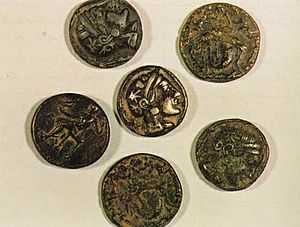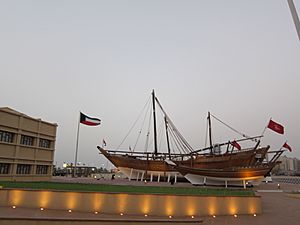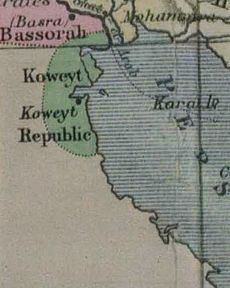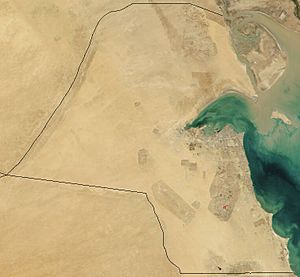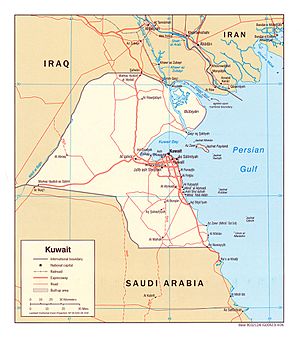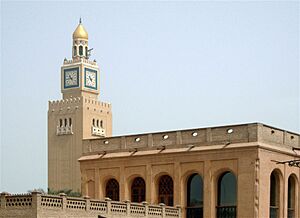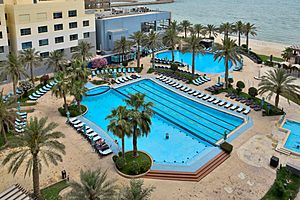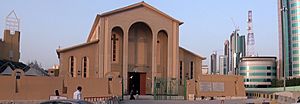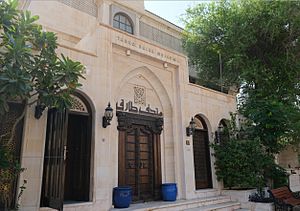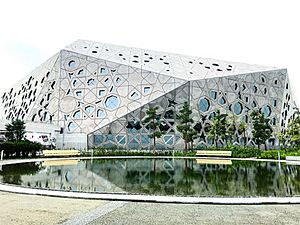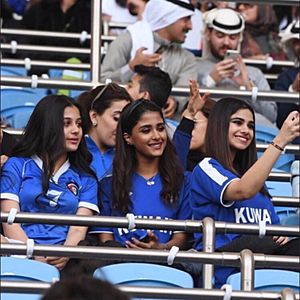Kuwait facts for kids
Quick facts for kids
State of Kuwait
|
|
|---|---|
|
|
|
|
Anthem: ٱلنَّشِيد ٱلْوَطَنِيّ
Al-Nashīd al-Waṭanī "National Anthem" |
|
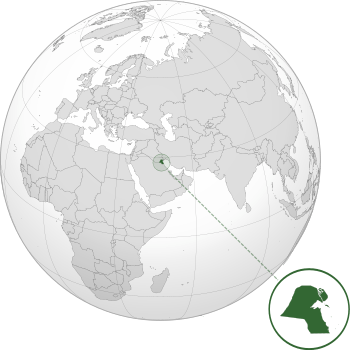
Location of Kuwait (green)
|
|
| Capital and largest city
|
Kuwait City |
| Official languages | Arabic |
| Other languages | English (lingua franca) • Tagalog • Gulf Pidgin Arabic (lingua franca) • Hindi • Persian • Bengali • Urdu • French • Malayalam • Pashto • Turkish • Armenian • Kurdish • Other minority languages spoken |
| Ethnic groups
(2018)
|
|
| Religion
(2013)
|
|
| Demonym(s) | Kuwaiti |
| Government | Unitary semi-constitutional monarchy |
|
• Emir
|
Mishal Al-Ahmad Al-Jaber Al-Sabah |
| Sabah Al-Khalid Al-Sabah | |
| Ahmad Al-Abdullah Al-Sabah | |
| Legislature | The National Assembly Emergency clauses invoked; suspended for the next four years |
| Establishment | |
|
• Sheikhdom of Kuwait
|
1752 |
|
• Anglo-Kuwaiti Agreement
|
23 January 1899 |
|
• Anglo-Ottoman Convention
|
29 July 1913 |
|
• End of treaties with the United Kingdom
|
19 June 1961 |
| 14 May 1963 | |
|
• Current Constitution
|
11 November 1962 |
|
• Kuwait Governorate
|
28 August 1990 |
|
• Restoration of Current Constitution
|
28 February 1991 |
| Area | |
|
• Total
|
17,818 km2 (6,880 sq mi) (152nd) |
|
• Water (%)
|
negligible |
| Population | |
|
• 2024 estimate
|
3,138,355 (137th) |
|
• Density
|
200.2/km2 (518.5/sq mi) (62nd) |
| GDP (PPP) | 2024 estimate |
|
• Total
|
|
|
• Per capita
|
|
| GDP (nominal) | 2024 estimate |
|
• Total
|
|
|
• Per capita
|
|
| HDI (2022) | very high · 49th |
| Currency | Kuwaiti dinar |
| Time zone | UTC+3 (AST) |
| Date format | dd/mm/yyyy |
| Driving side | left |
| ISO 3166 code | KW |
| Internet TLD | .kw |
|
|
Kuwait is a small country (about 17,819 square kilometers) in the Middle East.
Kuwait is the most socially progressive country in the Gulf region. It has a small and rich economy. It has about 96 billion barrels of crude oil reserves. Crude oil reserves are the oil that is still under the ground and has not yet been cleaned up. Kuwait has 10% of all of the oil reserves in the world.
The country makes a lot of money by selling oil. This money is almost half of all the money the country makes. The oil money is also 95% of the money made by selling things to different countries (people call that exports). Also, the oil money is 80% of the money the government makes. Kuwait is now talking with oil companies of other countries to make oil fields in the northern part of the country.
Kuwait's weather makes farming hard due to little rain. Instead of farming, the country catches fish and buys food from other countries.
About 75% of the country's water to drink has to be distilled (have the salt removed) or purchased from other countries.
In 1990, Iraq invaded (brought an army in to fight against) Kuwait. This started the first Gulf War.
Kuwait's official religion is Islam, although 15% of its population are Christian or Hindu. Arabic is mostly spoken in Kuwait but English is widespread among Kuwaitis (residents of Kuwait).
Kuwait is one of the few nations that has education for every age.
Contents
History
Historically, most of present-day Kuwait was part of ancient Mesopotamia.
Mesopotamians first settled in the Kuwaiti island of Failaka in 2000 B.C. Traders from the Sumerian city of Ur inhabited Failaka and ran a mercantile business. The island had many Mesopotamian-style buildings typical of those found in Iraq dating from around 2000 B.C. In 4000 BC until 2000 BC, Kuwait was home to the Dilmun civilization. Dilmun included Al-Shadadiya, Akkaz, Umm an Namil, and Failaka. At its peak in 2000 BC, Dilmun controlled the Persian Gulf trading routes.
During the Dilmun era (from ca. 3000 BC), Failaka was known as "Agarum", the land of Enzak, a great god in the Dilmun civilization according to Sumerian cuneiform texts found on the island. As part of Dilmun, Failaka became a hub for the civilization from the end of the 3rd to the middle of the 1st millennium BC. After the Dilmun civilization, Failaka was inhabited by the Kassites of Mesopotamia, and was formally under the control of the Kassite dynasty of Babylon. Studies indicate traces of human settlement can be found on Failaka dating back to as early as the end of the 3rd millennium BC, and extending until the 20th century AD. Many of the artifacts found in Falaika are linked to Mesopotamian civilizations and seem to show that Failaka was gradually drawn toward the civilization based in Antioch.

Under Nebuchadnezzar II, the bay of Kuwait was under Babylonian control. Cuneiform documents found in Failaka indicate the presence of Babylonians in the island's population. Babylonian Kings were present in Failaka during the Neo-Babylonian Empire period, Nabonidus had a governor in Failaka and Nebuchadnezzar II had a palace and temple in Falaika. Failaka also contained temples dedicated to the worship of Shamash, the Mesopotamian sun god in the Babylonian pantheon.
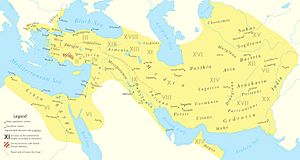
Following the Fall of Babylon, the bay of Kuwait came under the control of the Achaemenid Empire (c. 550‒330 BC) as the bay was repopulated after seven centuries of abandonment. Failaka was under the control of the Achaemenid Empire as evidenced by the archaeological discovery of Achaemenid strata. There are Aramaic inscriptions that testify Achaemenid presence.
In 4th century BC, the ancient Greeks colonized the bay of Kuwait under Alexander the Great. The ancient Greeks named mainland Kuwait Larissa and Failaka was named Ikaros. The bay of Kuwait was named Hieros Kolpos. According to Strabo and Arrian, Alexander the Great named Failaka Ikaros because it resembled the Aegean island of that name in size and shape. Some elements of Greek mythology were mixed with the local cults. "Ikaros" was also the name of a prominent city situated in Failaka. Large Hellenistic forts and Greek temples were uncovered. Archaeological remains of Greek colonization were also discovered in Akkaz, Umm an Namil, and Subiya.

At the time of Alexander the Great, the mouth of the Euphrates River was located in northern Kuwait. The Euphrates river flowed directly into the Persian Gulf via Khor Subiya which was a river channel at the time. Failaka was located 15 kilometers from the mouth of the Euphrates river. By the first century BC, the Khor Subiya river channel dried out completely.
In 127 BC, Kuwait was part of the Parthian Empire and the kingdom of Characene was established around Teredon in present-day Kuwait. Characene was centered in the region encompassing southern Mesopotamia, Characene coins were discovered in Akkaz, Umm an Namil, and Failaka. A busy Parthian commercial station was situated in Kuwait.
The earliest recorded mention of Kuwait was in 150 AD in the geographical treatise Geography by Greek scholar Ptolemy. Ptolemy mentioned the Bay of Kuwait as Hieros Kolpos (Sacer Sinus in the Latin versions).
In 224 AD, Kuwait became part of the Sassanid Empire. At the time of the Sassanid Empire, Kuwait was known as Meshan, which was an alternative name of the kingdom of Characene. Akkaz was a Partho-Sassanian site; the Sassanid religion's tower of silence was discovered in northern Akkaz. Late Sassanian settlements were discovered in Failaka. In Bubiyan, there is archaeological evidence of Sassanian to early Islamic periods of human presence as evidenced by the recent discovery of torpedo-jar pottery shards on several prominent beach ridges.
Most of present-day Kuwait is still archaeologically unexplored. According to several famous archaeologists and geologists, Kuwait was likely the original location of the Pishon River which watered the mythical Garden of Eden. Juris Zarins argued that the Garden of Eden was situated at the head of the Persian Gulf (present-day Kuwait), where the Tigris and Euphrates Rivers run into the sea, from his research on this area using information from many different sources, including LANDSAT images from space. His suggestion about the Pishon River was supported by James A. Sauer of the American Center of Oriental Research. Sauer made an argument from geology and history that Pishon River was the now-defunct Kuwait River. With the aid of satellite photos, Farouk El-Baz traced the dry channel from Kuwait up the Wadi Al-Batin.
In 636 AD, the Battle of Chains between the Sassanid Empire and Rashidun Caliphate was fought in Kuwait. At the time, Kuwait was under the control of the Sassanid Empire. The Battle of Chains was the first battle of the Rashidun Caliphate in which the Muslim army sought to extend its frontiers.
As a result of Rashidun victory in 636 AD, the bay of Kuwait was home to the city of Kazma (also known as "Kadhima" or "Kāzimah") in the early Islamic era. Medieval Arabic sources contain multiple references to the bay of Kuwait in the early Islamic period. According to medieval sources, the city functioned as a trade port and resting place for pilgrims on their way from Iraq to Hejaz. The city was controlled by the kingdom of Al-Hirah in Iraq. In the early Islamic period, the bay of Kuwait was known for being a fertile area. The Kuwaiti city of Kazma was also a stop for caravans coming from Persia and Mesopotamia en route to the Arabian Peninsula. The poet Al-Farazdaq, recognized as one of the greatest classical poets of the Arabs, was born in the Kuwaiti city of Kazma.
Christian Nestorian settlements flourished across the bay of Kuwait from the 5th century until the 9th century. Excavations have revealed several farms, villages and two large churches dating from the 5th and 6th century. Archaeologists are currently excavating nearby sites to understand the extent of the settlements that flourished in the eighth and ninth centuries A.D. An old island tradition is that a community grew up around a Christian mystic and hermit. The small farms and villages were eventually abandoned. Remains of Byzantine era Nestorian churches were found in Akkaz and Al-Qusur. Pottery at the site can be dated from as early as the first half of the 7th century through the 9th century.
1521–1918: Founding
In 1521, Kuwait was under Portuguese control. In the late 16th century, the Portuguese built a defensive settlement in Kuwait. In 1613, Kuwait City was founded as a fishing village. Administratively, it was a sheikhdom, ruled by local sheikhs from Bani Khalid clan. In 1682 or 1716, the Bani Utbah settled in Kuwait City, which at this time was still inhabited by fishermen and primarily functioned as a fishing village under Bani Khalid control. Sometime after the death of the Bani Khalid's leader Barrak Bin Urair and the fall of the Bani Khalid Emirate, the Utub were able to wrest control of Kuwait as a result of successive matrimonial alliances.
In the early eighteenth century, Kuwait prospered as a maritime port city and rapidly became the principal commercial center for the transit of goods between Baghdad, India, Muscat, and the Arabian Peninsula. By the mid-1700s, Kuwait had established itself as the major trading route from the Persian Gulf to Aleppo. During the Persian siege of Basra in 1775–79, Iraqi merchants took refuge in Kuwait and were partly instrumental in the expansion of Kuwait's boat-building and trading activities. As a result, Kuwait's maritime commerce boomed, as the Indian trade routes with Baghdad, Aleppo, Smyrna and Constantinople were diverted to Kuwait during this time. The East India Company was diverted to Kuwait in 1792. The East India Company secured the sea routes between Kuwait, India and the east coasts of Africa. After the Persians withdrew from Basra in 1779, Kuwait continued to attract trade away from Basra. The flight of many of Basra's leading merchants to Kuwait continued to play a significant role in Basra's commercial stagnation well into the 1850s.
According to Kuwaiti authors, the instability in Basra helped foster economic prosperity in Kuwait. In the late 18th century, Kuwait was a haven for Basra merchants fleeing Ottoman persecution. Kuwait was the center of boat building in the Persian Gulf, its ships renowned throughout the Indian Ocean. Kuwaitis also developed a reputation as the best sailors in the Persian Gulf. In the 19th century, Kuwait became significant in the horse trade, with regular shipments in sailing vessels. In the mid 19th century, it was estimated that Kuwait exported an average of 800 horses to India annually.
In the 1890s, threatened by the Ottoman Empire, ruler Sheikh Mubarak Al Sabah signed an agreement with the British government in India (subsequently known as the Anglo-Kuwaiti Agreement of 1899) making Kuwait a British protectorate. This gave Britain exclusive access and trade with Kuwait, while denying Ottoman provinces to the north a port on the Persian Gulf. The Sheikhdom of Kuwait remained a British protectorate until 1961.
During the reign of Mubarak, Kuwait was dubbed the "Marseilles of the Persian Gulf" because its economic vitality attracted a large variety of people. The population was cosmopolitan, ethnically and religiously diverse, including Arabs, Persians, Africans, Jews and Armenians. Kuwait was known for its religious tolerance.
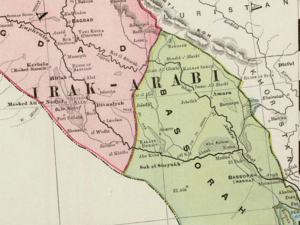
After the Anglo-Ottoman Convention of 1913, Kuwait was established as an autonomous kaza, or district, of the Ottoman Empire and a de facto protectorate of Great Britain.
In the first decades of the twentieth century, Kuwait had a well-established elite: wealthy trading families linked by marriage and shared economic interests, long-settled and urban, most claiming descent from the original 30 Bani Utubi families. The wealthiest were merchants who acquired their wealth from long-distance commerce, shipbuilding and pearling. They were a cosmopolitan elite who traveled extensively to India, Africa and Europe, and educated their sons abroad more than other Gulf Arab elite. Western visitors noted the Kuwaiti elite used European office systems, typewriters, and followed European culture with curiosity. The richest were involved in general trade. The Kuwaiti merchant families of Al-Ghanim and Al-Hamad were estimated to be worth millions before the 1940s.
In the early 20th century, Kuwait immensely declined in regional economic importance, mainly due to many trade blockades and the world economic depression. Before Mary Bruins Allison visited Kuwait in 1934, Kuwait lost its prominence in long-distance trade. During World War I, the British Empire imposed a trade blockade against Kuwait because Kuwait's ruler at the time, Salim Al-Mubarak Al-Sabah, supported the Ottoman Empire. The British economic blockade heavily damaged Kuwait's economy.
1919–1945: After World War I
The Kuwait–Najd War of 1919–20 erupted in the aftermath of World War I. The war occurred because Ibn Saud of Najd wanted to annex Kuwait. The sharpened conflict between Kuwait and Najd led to the death of hundreds of Kuwaitis. The war resulted in sporadic border clashes throughout 1919–1920.
Following the Kuwait–Najd War in 1919–20, Ibn Saud imposed a trade blockade against Kuwait from the years 1923 until 1937. The goal of the Saudi economic and military attacks on Kuwait was to annex as much of Kuwait's territory as possible. At the Uqair conference in 1922, the boundaries of Kuwait and Najd were set; as a result of British interference, Kuwait had no representative at the Uqair conference. After the Uqair conference, Kuwait was still subjected to a Saudi economic blockade and intermittent Saudi raiding.
Throughout the 1930s, Kuwaiti people opposed the British imposed separation of Kuwait from Iraq. In 1938, the "Free Kuwaiti Movement" was established by Kuwaiti youth who opposed British rule and submitted a petition requesting the Iraqi government reunifies Kuwait and Iraq. Due to fears of armed uprising in Kuwait, the Al Sabah agreed to the establishment of a legislative council to represent the "Free Kuwaiti Movement" demanding the reunification of Iraq and Kuwait. The council's first meeting in 1938 resulted in unanimous resolutions demanding the reunification of Kuwait and Iraq.
1946–1982: State-building
Between 1946 and 1982, Kuwait experienced a period of prosperity driven by oil and its liberal atmosphere. In popular discourse, the years between 1946 and 1982 are referred to as the "Golden Era of Kuwait". In 1950, a major public-work programme began to enable Kuwaitis to enjoy a modern standard of living. By 1952, the country became the largest oil exporter in the Persian Gulf region. This massive growth attracted many foreign workers, especially from Palestine, India, and Egypt – with the latter being particularly political within the context of the Arab Cold War. It was also in 1952 that the first masterplan of Kuwait was designed by the British planning firm of Minoprio, Spenceley, and Macfarlane.
In June 1961, Kuwait became independent with the end of the British protectorate and the Sheikh Abdullah Al-Salim Al-Sabah became Emir of Kuwait.
In the 1960s and 1970s, Kuwait was considered the most developed country in the region. Kuwait was the pioneer in the Middle East in diversifying its earnings away from oil exports. The Kuwait Investment Authority is the world's first sovereign wealth fund. From the 1970s onward, Kuwait scored highest of all Arab countries on the Human Development Index. Kuwait University was established in 1966. Kuwait's theatre industry was well known throughout the Arab world.
Present
Despite the political instability, Kuwait had the highest Human Development Index ranking in the Arab world from 2006 to 2009. China awarded Kuwait Investment Authority an additional $700 million quota on top of $300 million awarded in March 2012. The quota is the highest to be granted by China to foreign investment entities.
Under the Belt and Road Initiative, Kuwait and China have various cooperation projects including South al-Mutlaa which is currently under construction in northern Kuwait. The Sheikh Jaber Al-Ahmad Al-Sabah Causeway is part of the first phase of the Silk City project. The causeway was inaugurated in May 2019 as part of Kuwait Vision 2035, it connects Kuwait City to northern Kuwait.
Kuwait currently has the largest US military presence in the entire Middle East region. There are over 14,000 US military personnel stationed in the country. Camp Arifjan is the largest US military base in Kuwait. The US uses bases in Kuwait as staging hubs, training ranges, and logistical support for its Middle East operations.
Geography
Located in the north-east corner of the Arabian Peninsula, Kuwait is one of the smallest countries in the world in terms of land area. Kuwait lies between latitudes 28° and 31° N, and longitudes 46° and 49° E. Kuwait is generally low-lying, with the highest point being 306 m (1,004 ft) above sea level. Mutla Ridge is the highest point in Kuwait.
Kuwait has ten islands. With an area of 860 km2 (330 sq mi), the Bubiyan is the largest island in Kuwait and is connected to the rest of the country by a 2,380-metre-long (7,808 ft) bridge. 0.6% of Kuwaiti land area is considered arable with sparse vegetation found along its 499-kilometre-long (310 mi) coastline. Kuwait City is located on Kuwait Bay, a natural deep-water harbor.
Kuwait's Burgan field has a total capacity of approximately 70 billion barrels (11 billion cubic metres) of proven oil reserves. During the 1991 Kuwaiti oil fires, more than 500 oil lakes were created covering a combined surface area of about 35.7 km2 (13+3⁄4 sq mi). The resulting soil contamination due to oil and soot accumulation had made eastern and south-eastern parts of Kuwait uninhabitable. Sand and oil residue had reduced large parts of the Kuwaiti desert to semi-asphalt surfaces. The oil spills during the Gulf War also drastically affected Kuwait's marine resources.
Climate
Due to Kuwait's proximity to Iraq and Iran, the winter season in Kuwait is colder than other coastal countries in the region (especially UAE, Qatar, and Bahrain). Kuwait is also less humid than other coastal countries in the region. The spring season in March is warm with occasional thunderstorms. The frequent winds from the northwest are cold in winter and hot in summer. Southeasterly damp winds spring up between July and October. Hot and dry south winds prevail in spring and early summer. The shamal, a northwesterly wind common during June and July, causes dramatic sandstorms. Summers in Kuwait are some of the hottest on earth. The highest recorded temperature was 54.0 °C (129.2 °F) at Mitribah on 21 July 2016, which is the highest temperature recorded in Asia.
Kuwait emits a lot of carbon dioxide per person compared to most other countries. In recent years, Kuwait has been regularly ranked among the world's highest countries in term of CO2 per capita emissions.
Nature reserves
At present, there are five protected areas in Kuwait recognized by the IUCN. In response to Kuwait becoming the 169th signatory of the Ramsar Convention, Bubiyan Island's Mubarak al-Kabeer reserve was designated as the country's first Wetland of International Importance. The 50,948 ha reserve consists of small lagoons and shallow salt marshes and is important as a stop-over for migrating birds on two migration routes. The reserve is home to the world's largest breeding colony of crab-plover.
Biodiversity
Currently, 444 species of birds have been recorded in Kuwait, 18 species of which breed in the country. The arfaj is the national flower of Kuwait. Due to its location at the head of the Persian Gulf near the mouth of the Tigris–Euphrates river, Kuwait is situated at the crossroads of many major bird migration routes and between two and three million birds pass each year. Kuwait's marine and littoral ecosystems contain the bulk of the country's biodiversity heritage. The marshes in northern Kuwait and Jahra have become increasingly important as a refuge for passage migrants.
Twenty eight species of mammal are found in Kuwait; animals such as gerboa, desert rabbits and hedgehogs are common in the desert. Large carnivores, such as the wolf, caracal and jackal, are no longer present. Among the endangered mammalian species are the red fox and wild cat. Forty reptile species have been recorded although none are endemic to Kuwait.
Kuwait, Oman and Yemen are the only locations where the endangered smoothtooth blacktip shark is confirmed as occurring.
Kuwaiti islands are important breeding areas for four species of tern and the socotra cormorant. Kubbar Island has been recognised an Important Bird Area (IBA) by BirdLife International because it supports a breeding colony of white-cheeked terns.
Water and sanitation
Kuwait is part of the Tigris–Euphrates river system basin. Several Tigris–Euphrates confluences form parts of the Kuwait–Iraq border. Bubiyan Island is part of the Shatt al-Arab delta. Kuwait is partially part of the Mesopotamian Marshes. Kuwait does not currently have any permanent rivers within its territory. However, Kuwait does have several wadis, the most notable of which is Wadi al-Batin which forms the border between Kuwait and Iraq. Kuwait also has several river-like marine channels around Bubiyan Island, most notably Khawr Abd Allah which is now an estuary, but once was the point where the Shatt al-Arab emptied into the Persian Gulf. Khawr Abd Allah is located in southern Iraq and northern Kuwait, the Iraq-Kuwait border divides the lower portion of the estuary, but adjacent to the port of Umm Qasr the estuary becomes wholly Iraqi. It forms the northeast coastline of Bubiyan Island and the north coastline of Warbah Island.
Kuwait relies on water desalination as a primary source of fresh water for drinking and domestic purposes. There are currently more than six desalination plants. Kuwait was the first country in the world to use desalination to supply water for large-scale domestic use. The history of desalination in Kuwait dates back to 1951 when the first distillation plant was commissioned.
In 1965, the Kuwaiti government commissioned the Swedish engineering company of VBB (Sweco) to develop and implement a plan for a modern water-supply system for Kuwait City. The company built five groups of water towers, thirty-one towers total, designed by its chief architect Sune Lindström, called "the mushroom towers". For a sixth site, the Emir of Kuwait, Sheikh Jaber Al-Ahmed, wanted a more spectacular design. This last group, known as Kuwait Towers, consists of three towers, two of which also serve as water towers. Water from the desalination facility is pumped up to the tower. The thirty-three towers have a standard capacity of 102,000 cubic meters of water. "The Water Towers" (Kuwait Tower and the Kuwait Water Towers) were awarded the Aga Khan Award for Architecture (1980 Cycle).
Kuwait's fresh water resources are limited to groundwater, desalinated seawater, and treated wastewater effluents. There are three major municipal wastewater treatment plants. Most water demand is currently satisfied through seawater desalination plants. Sewage disposal is handled by a national sewage network that covers 98% of facilities in the country.
Administrative divisions
Kuwait is divided into six governorates: Al Asimah Governorate (or Capital Governorate); Hawalli Governorate; Farwaniya Governorate; Mubarak Al-Kabeer Governorate; Ahmadi Governorate; and Jahra Governorate. The governorates are further subdivided into areas.
Government
Kuwait is an emirate. The Emir is the head of state, he belongs to the Al Sabah ruling family. The political system consists of an appointed government and judiciary. The Constitution of Kuwait was promulgated in 1962.
Executive power is exercised by the government. The Emir appoints the prime minister, who in turn chooses the cabinet of ministers comprising the government.
The Emir appoints the judges. The Constitutional Court is charged with ruling on the conformity of laws and decrees with the constitution. Kuwait has an active public sphere and civil society with political and social organizations. Professional groups like the Chamber of Commerce, which represents the interests of Kuwaiti businesses and industries, maintain their autonomy from the government.
Legislative power is exercised by the Emir. It was formerly exercised by the National Assembly. As per article 107 of the Kuwait constitution, the Emir has the power to dissolve the assembly and elections for a new assembly should be held within two months.
Kuwaiti women are considered among the most emancipated women in the Middle East. In 2014 and 2015, Kuwait was ranked first among Arab countries in the Global Gender Gap Report. In 2013, 53% of Kuwaiti women participated in the labor force, where they outnumber working Kuwaiti men, giving Kuwait the highest female citizen participation in the workforce of any GCC country. According to the Social Progress Index, Kuwait ranks first in social progress in the Arab world and Muslim world and second highest in the Middle East after Israel. However, women's political participation in Kuwait has been limited. Despite multiple prior attempts at granting Kuwaiti women suffrage, they were not permanently enfranchised until 2005.
Kuwait ranks among the world's top countries by life expectancy, women's workforce participation, global food security, and school order and safety.
Economy
Kuwait is one of the richest countries in the world. The Kuwaiti dinar is the highest-valued unit of currency in the world. According to the World Bank, Kuwait is the fifth richest country in the world by gross national income per capita, and one of five nations with a GNI per capita above $70,000.
In the past five years, there has been a significant rise in entrepreneurship and small business start-ups in Kuwait.
Kuwait's main export products are mineral fuels including oil (89.1% of total exports), aircraft and spacecraft (4.3%), organic chemicals (3.2%), plastics (1.2%), iron and steel (0.2%), gems and precious metals (0.1%), machinery including computers (0.1%), aluminum (0.1%), copper (0.1%), and salt, sulphur, stone and cement (0.1%). Kuwait was the world's biggest exporter of sulfonated, nitrated and nitrosated hydrocarbons in 2019. Kuwait was ranked 63rd out of 157 countries in the 2019 Economic Complexity Index (ECI).
Science and technology
Kuwait has a growing scientific research sector. As of 31 December 2015, Kuwait is the second largest patent producer in the Arab world. Kuwait was ranked 64th in the Global Innovation Index in 2023.
Kuwait was the first country in the region to implement 5G technology. Kuwait is among the world's leading markets in 5G penetration.
Education
Kuwait had the highest literacy rate in the Arab world in 2010. The general education system consists of four levels: kindergarten (lasting for 2 years), primary (lasting for 5 years), intermediate (lasting for 4 years) and secondary (lasting for 3 years). Schooling at primary and intermediate level is compulsory for all students aged 6 – 14. All the levels of state education, including higher education, are free. The public education system is undergoing a revamp due to a project in conjunction with the World Bank. Post-secondary education comprises technical and vocational courses offered by the Public Authority for Applied Education and Training (PAAET), a state institution, and degree programs offered by Kuwait University, and 14 private universities.
Tourism
In 2020, Kuwait's domestic travel and tourism spending reached $6.1 billion (up from $1.6 billion in 2019) with family tourism a rapidly growing segment. The WTTC named Kuwait as one of the world's fastest-growing countries in travel and tourism GDP in 2019, with 11.6% year-on-year growth. In 2016, the tourism industry generated nearly $500 million in revenue. In 2015, tourism accounted for 1.5 percent of the GDP. Sabah Al Ahmad Sea City is one of Kuwait's biggest attractions.
The Amiri Diwan recently inaugurated the new Kuwait National Cultural District (KNCD), which comprises Sheikh Abdullah Al Salem Cultural Centre, Sheikh Jaber Al Ahmad Cultural Centre, Al Shaheed Park, and Al Salam Palace. With a capital cost of more than US$1 billion, the project is one of the largest cultural investments in the world. The Kuwait National Cultural District is a member of the Global Cultural Districts Network. Al Shaheed Park is the largest green roof project ever undertaken in the Arab world. The annual "Hala Febrayer" festival attracts many tourists from neighboring GCC countries, and includes a variety of events including music concerts, parades, and carnivals. The festival is a month-long commemoration of the liberation of Kuwait, and runs from 1 to 28 February. Liberation Day itself is celebrated on 26 February.
Demographics
Kuwait's 2018 population was 4.6 million people, of which 1.8 million were Kuwaitis, 800,000 are other Arabs, 1.6 million Asian expatriates, and 47,227 Africans.
Religion
Kuwait's official state religion is Maliki Sunni Islam. Kuwait also has a large community of expatriate Christians, Hindus, Buddhists, and Sikhs.
Languages
Kuwait's official language is Modern Standard Arabic, but its everyday usage is limited to journalism and education. Kuwaiti Arabic is the variant of Arabic used in everyday life. English is widely understood and often used as a business language. Besides English, French is taught as a third language for the students of the humanities at schools, but for two years only.
Cuisine
Kuwaiti cuisine is a fusion of Arabian, Iranian, and Mesopotamian cuisines. Kuwaiti cuisine is part of the Eastern Arabian cuisine. A prominent dish in Kuwaiti cuisine is machboos, a rice-based dish usually prepared with basmati rice seasoned with spices, and chicken or mutton.
Seafood is a significant part of the Kuwaiti diet, especially fish. Mutabbaq samak is a national dish in Kuwait. Other local favourites are hamour (grouper), which is typically served grilled, fried, or with biryani rice because of its texture and taste; safi (rabbitfish); maid (mulletfish); and sobaity (sea bream).
Kuwait's traditional flatbread is called Iranian khubz. It is a large flatbread baked in a special oven and it is often topped with sesame seeds. Numerous local bakeries dot the country; the bakers are mainly Iranians (hence the name of the bread, "Iranian khubuz"). Bread is often served with mahyawa fish sauce.
Culture
Kuwaiti popular culture, in the form of theatre, radio, music, and television soap opera, flourishes and is even exported to neighboring states. Within the Arab states of the Persian Gulf, the culture of Kuwait is the closest to the culture of Bahrain; this is evident in the close association between the two states in theatrical productions and soap operas.
Museums
The new Kuwait National Cultural District (KNCD) consists of various cultural venues including Sheikh Abdullah Al Salem Cultural Centre, Sheikh Jaber Al Ahmad Cultural Centre, Al Shaheed Park, and Al Salam Palace. With a capital cost of more than US$1 billion, it is one of the largest cultural districts in the world. The Abdullah Salem Cultural Centre is the largest museum complex in the Middle East. The Kuwait National Cultural District is a member of the Global Cultural Districts Network.
Sadu House is among Kuwait's most important cultural institutions. Bait Al-Othman is the largest museum specializing in Kuwait's history. The Scientific Center is one of the largest science museums in the Middle East. The Museum of Modern Art showcases the history of modern art in Kuwait and the region. The Kuwait Maritime Museum presents the country's maritime heritage in the pre-oil era. Several traditional Kuwaiti dhow ships are open to the public, such as Fateh Al-Khayr and Al-Hashemi-II which entered the Guinness Book of World Records as the largest wooden dhow ever built. The Historical, Vintage, and Classical Cars Museum displays vintage cars from Kuwait's motoring heritage. The National Museum, established in 1983, has been described as "underused and overlooked".
Several Kuwaiti museums are devoted to Islamic art, most notably the Tareq Rajab Museums and Dar al Athar al Islamiyyah cultural centres. The Dar al Athar al Islamiyyah cultural centres include education wings, conservation labs, and research libraries. There are several art libraries in Kuwait. Khalifa Al-Qattan's Mirror House is the most popular art museum in Kuwait. Many museums in Kuwait are private enterprises. In contrast to the top-down approach in other Gulf states, museum development in Kuwait reflects a greater sense of civic identity and demonstrates the strength of civil society in Kuwait, which has produced many independent cultural enterprises.
Sport
Football is the most popular sport in Kuwait. The Kuwait Football Association (KFA) is the governing body of football in Kuwait. The KFA organises the men's, women's, and futsal national teams. The Kuwaiti Premier League is the top league of Kuwaiti football, featuring eighteen teams. The Kuwait national football team have been the champions of the 1980 AFC Asian Cup, runners-up of the 1976 AFC Asian Cup, and have taken third place of the 1984 AFC Asian Cup. Kuwait has also been to one FIFA World Cup, in 1982; they drew 1–1 with Czechoslovakia before losing to France and England, failing to advance from the first round. Kuwait is home to many football clubs including Al-Arabi, Al-Fahaheel, Al-Jahra, Al-Kuwait, Al-Naser, Al-Salmiya, Al-Shabab, Al Qadsia, Al-Yarmouk, Kazma, Khaitan, Sulaibikhat, Sahel, and Tadamon. The biggest football rivalry in Kuwait is between Al-Arabi and Al Qadsia.
Basketball is one of the country's most popular sports. The Kuwait national basketball team is governed by the Kuwait Basketball Association (KBA). Kuwait made its international debut in 1959. The national team has been to the FIBA Asian Championship in basketball eleven times. The Kuwaiti Division I Basketball League is the highest professional basketball league in Kuwait. Cricket in Kuwait is governed by the Kuwait Cricket Association. Other growing sports include rugby union. Handball is widely considered to be the national icon of Kuwait, although football is more popular among the overall population.
Ice hockey in Kuwait is governed by the Kuwait Ice Hockey Association. Kuwait first joined the International Ice Hockey Federation in 1985, but was expelled in 1992 due to a lack of ice hockey activity. Kuwait was re-admitted into the IIHF in May 2009. In 2015, Kuwait won the IIHF Challenge Cup of Asia.
In February 2020, Kuwait held for the first time a leg of the UIM Aquabike World Championship in front of Marina Beach City.
In May 2022, Kuwait hosted the Third Gulf Cooperation Council (GCC) Games at the 360 Marina. The event featured 16 different sports, including volleyball, basketball, swimming, athletics, karate and judo and attracted over 1,700 male and female players.
Related pages
Images for kids
-
A theatrical play titled "Fateh Masr" at Al Mubarikya school in the 1940s.
See also
 In Spanish: Kuwait para niños
In Spanish: Kuwait para niños




